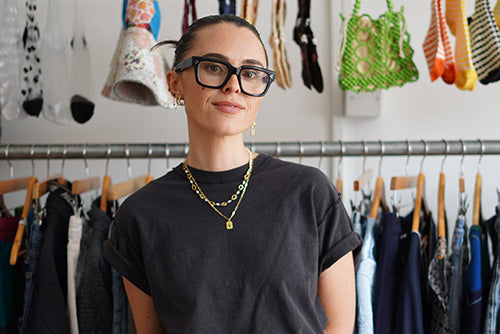The reality of retail design
In visual merchandising, the seasons have historically been punctuated by window displays. The excitement and speculation that built before Christmas to see the unveiling of the Selfridges windows, for example, was a long-standing London attraction. Today, the seasons no longer dictate the refurbishment of a window display. We are so accustomed to a spectacle that the only way to grab shoppers’ attention is with new-ness, which means constant change, and a lot of waste.
Vinyl, lighting, mannequins, images, custom display stands, mirrors, bespoke furniture and decorative materials are just a few of the elements that constitute window displays, which some retailers update twice in a month. This doesn’t account for the tables, signage, rails, shelving, units and more that make up the visual merchandising of an entire store.

In recent years we’ve noticed a proliferation of eyewear stores appearing around London, some of which have disappeared shortly afterwards. We can only imagine the volume of waste this will generate in the future. When we take a moment to consider that most visual merchandising is not designed with sustainability in mind, meaning the components are unable to be used in the next location, or recycled responsibly, it creates the question; where does it all go?
Images of piles of wasted retail displays and shop kit outs is enough to make anyone miserable, but there has been a shift towards more sustainable window displays. Ganni’s flagship soho store have display units made from Smile plastics - recycled plastic. Anya Hidmarch launched their ‘I am a Plastic Bag’ campaign in 2020 with a window display made of 9000 recycled plastic bottles. Aesop’s store materials and furnishings from refurbished, closed or relocated stores are reused wherever possible, extending their lifespan and avoiding unnecessary waste. And even Selfridges’ Project Earth campaign has brought increasingly eco-focused window displays to the famous street.

We adopted a similar approach in 2021 when we opened our first store on Chiltern street. The store was designed to consider sustainability in every aspect; built to be repurposed, recycled or returned to the earth leaving minimal impact.
A great example is our mirrors which are either propped up by salvaged concrete (taken from a construction site), or wall mounted with brackets made from custom apricot recycled Smile Plastics - a post consumer recycled plastics company doing amazing things (check out their work with Ganni too).
Why is this a big deal? Typically, mirrors are glued to the walls in retail, meaning they shatter on disassembly and can no longer be used. Because of these brackets, we can take our mirrors with us.
We’ve used the same recycled plastic for our countertop, bench, and shelves, all of which can be repurposed in the home.

When conceptualising our standout ceiling installation, we came across cornstarch. It’s biodegradable, non toxic and devolves in water. We even decided to use it to support our frames instead of using standard shelving.
We’ve used mycelium for our display podiums, biodegradable and beautifully natural, they punctuate our shop floor. Hemp, a sustainable alternative to plastic, is what covers our storage in the form of curtains and panelling.

This might sound like we’re tooting our own horn, but we promise that’s not our intention, we’re simply trying to highlight how sustainable, low-impact visual merchandising is achievable, and that it should be the norm, not the anomaly.
Unsurprisingly, it’s hard to find concrete data on the impact of wasted visual merchandising, but more and more brands are giving us hope that a much-needed shift towards low-impact design is on the way, not just when it comes to window displays but entire retail concepts.
As always, we’ll continue to refresh our window without adding to the problem, whether it’s utilising our mycelium plinths and salvaged objects, giving old Monocle Magazines a new purpose in our latest MONC x Monocle Window display, or growing our window display… we’ll share more on that next week.



